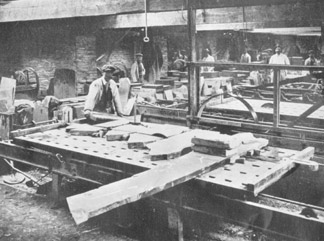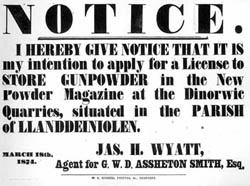Quarrying Techniques - The Quarry and
Blasting
 (It is very important to bear in mind that since
the quarrying was a Welsh language industry, the
translations into English are only meant to give an idea of the
meaning of the original. These English versions are modern
literal translations. It is important to know that the
terminology did vary to some extent from area to area. The terms
used here are in the main from the Llanberis area.) (It is very important to bear in mind that since
the quarrying was a Welsh language industry, the
translations into English are only meant to give an idea of the
meaning of the original. These English versions are modern
literal translations. It is important to know that the
terminology did vary to some extent from area to area. The terms
used here are in the main from the Llanberis area.)
It is claimed that it was Richard Pennant, the first
Lord Penrhyn, who was responsible for the
idea of working his quarry using ponciau (galleries)
linked to other ponciau with bariau (rails) running
down the gelltydd (slopes) from one bonc
(gallery) to the other for the car cyrn (lit. horned
cart a cart with two iron bars at the front to prevent the load
of pileri (pillars) and clytiau from falling off.) In some
quarries, a blondin or winsh (aerial ropeways) were
used, (so named after Blondin the great tight rope walker.) This
wire rope ran above the quarry or sinc to lift loads of
rubble or slate. Steam power was used to work these before the
advent of electricity. All of the ponciau would be given
names of a most interesting character like Abyssinia,
California, Giarat, New York, Edward Jones, Robin Dre, Ruban
Glas and Wembley to note but a few.
Blasting
 Powdwr Du (Gunpowder) was used
every time since dynamite or gelignite would shatter the slate.
The gunpowder was stored in the ty powdwr or cwt
powdwr, (magazine) and before entering one had to wear copper
soled clogs to lessen the danger of striking a spark. A bag
powdwr (lit. powder bag) made of cloth or rubber was used to
carry the gunpowder to the quarry face for blasting. Of course,
dynamite or gelignite was used to blast away rubble to get at the
slate. Powdwr Du (Gunpowder) was used
every time since dynamite or gelignite would shatter the slate.
The gunpowder was stored in the ty powdwr or cwt
powdwr, (magazine) and before entering one had to wear copper
soled clogs to lessen the danger of striking a spark. A bag
powdwr (lit. powder bag) made of cloth or rubber was used to
carry the gunpowder to the quarry face for blasting. Of course,
dynamite or gelignite was used to blast away rubble to get at the
slate.
Before the age of pneumatic drills the jympar (lit. jumper,
a long weighted rod [usually around 2m, but could be
longer]. It was used repeatedly thrusting to bore a shot
hole.) About 15cms from one end is a ball of iron to produce
extra weight. The jympar is used, by thrusting its short
end, until the iron ball reaches the mouth of the shot hole. It
is then reversed and thrust repeatedly again until reaching the
iron ball for the second time. Sometimes powdwr du is
placed in fissures instead.
Great care must be taken to powdro (lit. powder)
properly, knowing exactly how much powder to use, but also how
much stamping is required to loosen the rock safely and
not cause injury to anybody. If proper care is not taken the
(hole can fire) – twll yn tanio, causing possible severe
injury. Saethu (lit. firing) can happen five or six times
a day at set hours. When the corn (bugle) is sounded all
the quarry men go to the caban mochal ffiar, (the cabin to
shelter from the fire.) Three minutes later the corn
is sounded again signalling that it is time to light
(tanio) the fuse with either a cigarette or match, (never
by electricity.) After this, all the tanwyr (lit. firers)
run to the cwt mochal ffiar for a smoke or chat. Then
after three or four minutes resounding explosions are heard
throughout the quarry and the sound of tons of rock falling to
the base of each bargen whilst mwg cur yn y pen (lit.
headache smoke) covers everything and everywhere. Each quarry
man has an unexplainable ability to recognise his own particular
explosion. Eight minutes after the first firing call the corn
heddwch (lit. peace bugle) is sounded to signify that the
firing session is over.
|